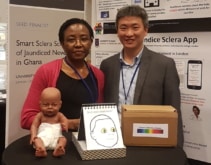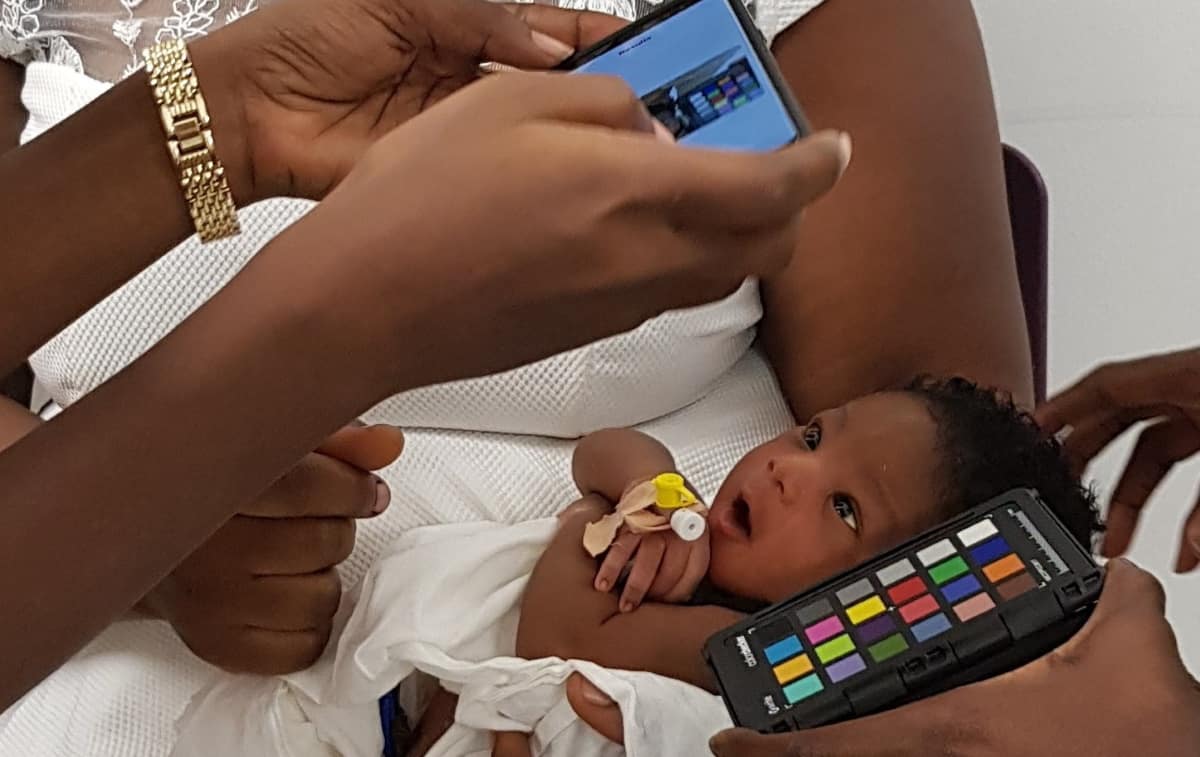
A smartphone app developed at University College London (UCL) identifies severe jaundice in newborn infants by scanning their eyes. The tool could prove invaluable in areas of the world that lack access to expensive screening devices.
A collaborative clinical study by researchers at UCL and the University of Ghana has now confirmed that the diagnostic performance of the neoSCB (neonatal scleral-conjuctival bilirubin) app is comparable to that of a conventional jaundice screening device.
Neonatal jaundice is caused by high levels of the pigment bilirubin in the blood, which build up when a newborn’s immature liver cannot remove bilirubin rapidly enough. Because bilirubin is toxic to the brain, if it crosses the blood–brain barrier it can cause brain damage. Without rapid treatment, an infant may suffer from permanent neurological dysfunction, developmental delays, hearing loss or even death.
The concentration of bilirubin in an infant’s blood can be assessed using a laboratory blood test or a transcutaneous bilirubinometer (TcB), a point-of-care device that takes a contact-based optical measurement of the skin. However, neither may be available to infants in low-resource countries and remote areas. Inability to test is a serious problem, because neonatal jaundice affects more than half of infants in their first week of life, a significant proportion of whom will need treatment.
Terence Leung, the developer of the technology behind the neoSCB app, explains that the smartphone camera technique works by quantifying the colour of the sclera (the white of the eye), as the degree of sclera yellowing is indicative of the systemic concentration of bilirubin. Leung and colleagues have been investigating the use of digital photography to measure sclera colour, and using this to quantify the scleral-conjunctival bilirubin (SCB), since 2014.
The app also incorporates ambient light subtraction, using the smartphone screen (front camera imaging) or the LED flash (rear camera imaging) to illuminate the subject. “This design explicitly addresses the confounding factors in colour measurement of jaundice – ambient light, camera characteristics and skin tone – while avoiding the need for add-ons or in-shot colour calibration cards,” Leung explains.
Clinical assessment
Following an initial pilot study on 37 newborns at University College Hospital London, the team performed a year-long study on 724 newborn babies in Ghana, publishing the findings in Pediatrics. The study was conducted at the Greater Accra Regional Hospital and at the Holy Family Hospital Nkawkaw, a district hospital in the Eastern Region.

The researchers used a Samsung Galaxy SB smartphone to record two images of each infant’s eye, with the LED flash on and off, enabling the use of ambient subtraction to minimize the effects of ambient light. To validate the diagnostic performance of the SCB level measured by the app, they also performed a TcB measurement using a Dräger JM-105 jaundice meter, plus a laboratory blood test, the gold standard to verify total serum bilirubin (TSB) levels.
Early in the study, the researchers optimized the neoSCB app by establishing an appropriate subtracted signal-to-noise ratio (SSNR) for quality control. The real-time SSNR is displayed on the app, making it easier to operate. They also added an option to zoom in on the captured image and manually choose an area-of-interest on the sclera to obtain a real-time calculated SCB value.
Principal investigators Christabel Enweronu-Laryea, of the University of Ghana Medical School, and Leung report that of the 336 infants who had not been previously treated for jaundice, the neoSCB app identified 74 out of 79 severely jaundiced newborns. By comparison, the TcB identified 76. The app exhibited reasonably high sensitivity and specificity, with a similar diagnostic accuracy to the JM-105 jaundice meter.
The TcB correlation with TSB was higher than SCB/TSB correlation, which had higher variance particularly when TSB was greater than the screening threshold of 14.62 mg/dl. The neoSCB app underestimated bilirubin at higher values of TSB, while the JM-105 gave no numerical values in similar conditions. The authors note that these findings are not clinically relevant for the smartphone app, which is designed to detect TSB levels that require additional clinical assessment and blood tests. However, they caution that the app should not be used in infants with a gestational age of less than 37 weeks, because it underestimates the scleral yellowness in preterm infants.
In addition to the hospital validation, 11 community healthcare workers in three rural communities in the Eastern region assessed the neoSCB app. They mastered its use with about 30 min of training and believe that it will be a highly effective and easy-to-use screening tool, especially since images and data can be electronically transmitted to hospitals when infants need additional testing.

Dose measurement system could improve phototherapy for jaundiced newborns
“The neoSCB method was acceptable to mothers in urban and rural communities where the study was conducted. Mothers easily devised ways to keep the baby’s eye open, most often by initiating breastfeeding,” says Enweronu-Laryea. The researchers find the feedback from both the mothers and community healthcare workers encouraging, because many infants in sub-Saharan Africa have increased risk of severe jaundice due to the high prevalence of a genetic disorder associated with an increased risk of haemolysis (the destruction of red blood cells) and hyperbilirubinemia.
Now that the diagnostic algorithm in the neoSCB app has been validated, its user interface will be improved further to make it more user-friendly for healthcare workers. The researchers hope that the app can either be used independently, or integrated into established maternal–child healthcare apps as an additional functionality. The team is seeking international partners for the next steps of regulatory approval (FDA, CE mark and MHRA, for example) from countries where the neoSCB app would be used.
